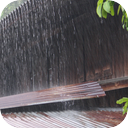(short preview of full seamless looping track)
Rain On Corrugated Iron
This product is not available in the selected currency.
In Stock
Backordered
Out of Stock
Description
The rain clouds have risen and remained overhead, pouring down a million buckets of warm water, carrying every little thing not nailed down into the sewer and nearby river. If you were standing in that sunless soup, you would probably drown just from having to feel the billions of water drops drenching every part of your skin. Luckily you are covered by a thick piece of corrugated iron, not to mention a lovely new hat. Corrugated galvanised iron, commonly abbreviated as CGI, is a building material composed of sheets of hot-dip galvanised mild steel, cold-rolled to produce a linear corrugated pattern in them. The corrugations increase the bending strength of the sheet in the direction perpendicular to the corrugations, but not parallel to them. CGI is lightweight and easily transported. It was and still is widely used especially in rural and military buildings such as sheds and water tanks. Its unique properties were used in the development of countries like Australia from the 1840s, and it is still helping developing countries today. CGI was invented in the 1820s in Britain by Henry Palmer, architect and engineer to the London Dock Company. It was originally made from wrought iron. It proved to be light, strong, corrosion-resistant, and easily transported, and particularly lent itself to prefabricated structures and improvisation by semi-skilled workers. It soon became a common construction material in rural areas in the United States, Chile, New Zealand and Australia and later India. In Australia and Chile it remains the most common roofing material even in urban areas. In Australia and New Zealand particularly it has become part of the cultural identity, and fashionable architectural use has become common.
Opps
Sorry, it looks like some products are not available in selected quantity.



